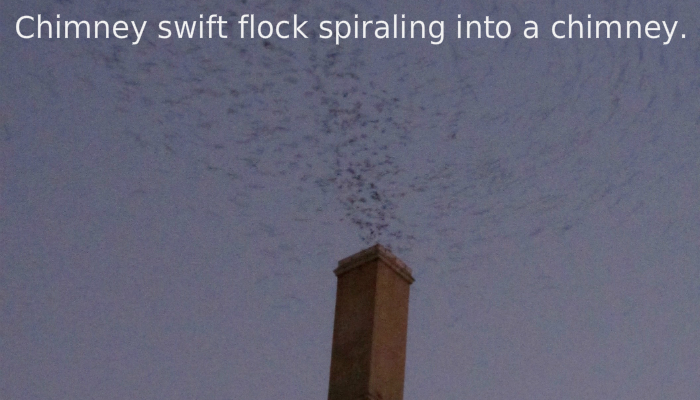A Chimney Swift View from the Roof, from the Past to the Future
My son Reed bought an old house in Oxford, badly in need of repair. So one fine June morning we found ourselves perched on the peak of the roof, dismantling the crumbly old chimney to down to below roof line and inserting a metal sleeve liner. In the process, we uncovered the remains of several generations of chimney swift nests, and looking out across town from our high vantage we observed a veritable forest of old chimneys in various stages of decay, while the swifts swooped and careened about them. From their perspective, there were certainly a lot more hollow chimneys in town than hollow trees. We were apparently not the first to have this specific vantage point, because we also found the remains of two other chimneys buried in the house walls, abandoned as fuel technology changed from wood to coal to oil to gas, and the soft brick slowly changed back to mud.
While we perched up there with the birds, carefully pulling out the rotten bricks a piece at a time, I considered the evolution of chimneys and the little birds so closely associated with them as to bear their name. Long ago, most homes simply had a smokehole in the roof, whether a Celtic peasant’s wattle-and-daub hut or a Hopi Hogan. This made for smoky living, although after existing in a cloud of woodsmoke all winter, the mosquitoes probably didn’t bother you in summer. A frozen fossil Eskimo woman was found to have a severe case of black lung at age 30. Somewhere around the 7th century, Europeans began enclosing their indoor hearths to direct the smoke to the hole in the roof. These were pleated from green sticks and heavily plastered with mud; construction that any robin would recognize. A chimney fire back then, often meant that the chimney was actually on fire, and it had to be torn down quickly before it spread into the roof and walls. Europeans brought this ancient technology to their “New World” and it so closely matched the construction practices of Chaetura pelagica that these birds promptly adapted their nesting behavior to this new substrate. Or maybe they were forced to, in a Darwinian sense, because their hollow trees soon thereafter vanished from the landscape, many of them going up the chimney.
But technology and fuels continued to evolve. Modern understanding of combustion and draft has consistently shown that the old chimneys are simply too big, allowing currents of cold air to circulate down while the flue gas goes up. In our time, chimneys have become small-diameter metal tubes poking through the roof. Some modern efficient gas furnaces today have no chimney, with warm exhaust gasses simply being blown out through a little plastic pipe in the wall, like a clothes dryer vent. Depending upon what we choose to subsidize, or not subsidize, our household energy future will be some mix of natural gas, nuclear or coal electric, solar, and wood; none of which provide habitat for the swifts. What is the future of a little bird, now quite dependent upon the relics of a half-century-old human technology and with no obvious prospects for a new domestic niche?
One approach, by Paul and Georgean Kyle is to simply build free-standing structures in the yard that are shaped like chimneys. Their books detail how to build them, demonstrate that they work, and reveal an amazing love affair between them and the swifts.
But their constructions are apparently more elaborate than most homeowners are willing to build or invest in, as witnessed by the fact that there are so few of them around, decades after they were proven to be functional.
So I am proposing that we build fake chimneys, which are added to the roofs of houses, garages, and sheds. These could perhaps be lightweight plywood and sheet metal, and simply a more complex birdhouse. The big unknown, and limiting factor, is probably height. Real brick chimneys have a lot of depth and are solidly anchored and insulated by being enclosed by the house. A tall add-on plywood ersatz chimney is going to shake in the wind and maybe work itself loose over time. Difficult to anchor without putting screws, nails, or bolts into the roofing, which will eventually lead to leaks. Maybe attach one to an existing chimney? Maybe add one to a shed roof where a small occasional leak isn’t a really big deal? Or is modern flexible caulking adequate?
If you are interested in the concept, I suggest that you begin by reading the little books below. Sorry, I don’t have any hands-on experience and a prototype to share with this proposal: 1) Chimney Swifts, America’s Mysterious Birds above the Fireplace, 2) Chimney Swift Towers, New Habitat for America’s Mysterious Birds, A Construction Guide.
Note that the Kyles stress heat buildup as being a limiting factor in their towers. But that is in Texas. Here, we might be able to manage heat adequately with simple insulation, ventilation, and tracking early afternoon shade.
An earlier version of this appeared in WINGS, the former journal of the Johnson County Songbird Project. Reused with permission from Jim Walters. Photo taken by waltarrrrr on Flickr creative commons.



